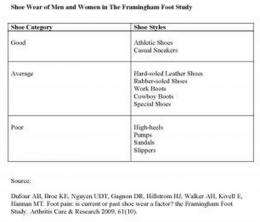Women who make poor shoe choices at risk for foot pain later in life

A recently published study determined that women who make poor shoe choices early in life suffer with foot pain in later years. Research shows that men do not experience the same foot pain as women, due to type of shoes they wear. Details of this study appear in the October issue of Arthritis Care & Research, a journal published by Wiley-Blackwell on behalf of the American College of Rheumatology.
National data reveal that foot and toe symptoms are among the top 20 reasons patients ages 65-74 visit their physician. In the U.S., foot pain is considered a very common musculoskeletal symptom and occurs in such conditions as rheumatoid arthritis, diabetes, and gout, or with sprains, muscle strains, bruises, and fractures. Previous studies have determined a correlation between improper footwear and foot pain, but this research focused on small patient samples or disease specific studies.
Researchers from Boston University School of Public Health and the Institute for Aging Research at Hebrew SeniorLife enrolled 3,372 participants in the Framingham Foot Study. Participants were derived from 2 large population-based samples of residents from Framingham, Massachusetts. The first group was part of the Framingham Study Original Cohort (formed in 1948) and the Framingham Offspring Cohort (formed in 1972) that were originally studied for heart disease risk factors. The second group was a new population sample derived from census data and included subjects who were at least 50 years old and ambulatory who were added to increase participation by minority persons.
The Framingham Foot Study assessed 1,472 men and 1,900 women between 2002 and 2008. Subjects were asked if they experienced pain, aching, or stiffness in either or both feet. Data on specific areas of foot pain was identified in the nails, forefoot, hindfoot, heel, arch of the foot, and ball of the foot. Participants provided information on current and past shoewear across five age groups: 20-29 years, 30-44 years, 45-64 years, 65-74 years, and 75+ years. Shoewear was classified as good (low risk shoes including athletic and casual sneakers), average (mid risk shoes such as hard- or rubber-soled shoes, special shoes and work boots), and poor shoes (high-risk shoewear that lack support and sound structure, including high-heeled shoes, sandals, and slippers).
According to the study 25% of participants reported generalized foot pain on most days with 19% of men and 29% of women falling into this subtype. "In women, we found an increased risk between hindfoot pain and shoewear," said the authors. The study revealed that only a small percentage (< 2%) of men wore poor shoes, thus shoe type is not a major factor for developing foot pain in men. "while more research is needed, young women should make careful choices regarding their shoe type to avoid hindfoot pain later in life, or perform stretching exercises to alleviate the effect of high heels on foot pain," recommended researchers.
Hebrew SeniorLife Tip for Healthy Aging
Wear Properly Fitting Shoes
Poor fitting shoes can cause a number of foot problems for diabetics and non-diabetics alike. They can cause bunions, corns, calluses, hammertoes and other disabling foot problems that are a significant public health risk in the United States. More than 43 million Americans have foot problems, many of which are serious enough to warrant medical attention.
Alyssa B. Dufour, a graduate student in the Musculoskeletal Research Program at the Institute for Aging Research of Hebrew SeniorLife and the lead author of a recent study on shoe wear and foot pain, suggests the following tips for making sure your shoes fit properly:
• Comfort—rather than style or fashion—should rule shoe selection.
• Judge shoes by how they fit, not by the size marked on the box; shoe sizes vary by brand and style.
• Have both feet measured when you purchase shoes; foot size increases with age.
• Fit shoes to your longest foot; most people have one foot that is larger than the other.
• Avoid high-heels and shoes with pointed or tapered toes.
• Fit shoes at the end of the day when your feet are their longest.
• Try on both shoes and walk a few steps to make sure they are comfortable.
• When the shoes are on, wiggle your toes to ensure that you can move them freely.
Ms. Dufour says to keep in mind this basic principle: your shoes should conform to the shape of your foot—your feet should never conform to the shape of your shoes.
More information: "Foot Pain: Is Current or Past Shoewear a Factor?" Alyssa B. Dufour, Kerry E. Broe, Anne H. Walker, Erin Kivell, Uyen-Sa D.T. Nguyen, Marian T. Hannan, David R. Gagnon, Howard J. Hillstrom. Arthritis Care & Research; Published Online: September 29, 2009 (DOI: 10.1002/art.24733); Print Issue Date: October 2009.















